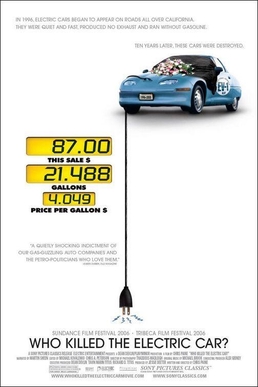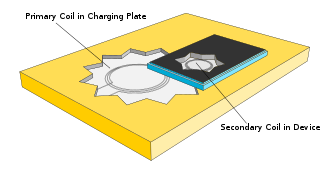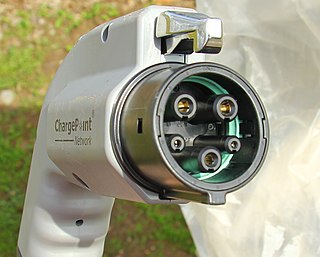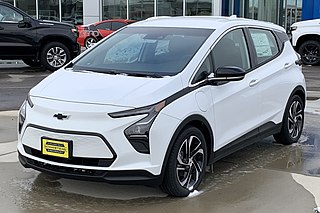
Magne Charge (also known as Magne-Charge, MagneCharge and J1773) is an obsolete inductive charging system used to charge battery electric vehicles (BEVs). [1] [2]

Magne Charge (also known as Magne-Charge, MagneCharge and J1773) is an obsolete inductive charging system used to charge battery electric vehicles (BEVs). [1] [2]
It was produced by General Motors subsidiary Delco Electronics, based on SAE recommended practice J1773 [3] for vehicles, primarily the EV1, the Chevy S10 EV, but also including the Nissan Altra and the first generation Toyota RAV4 EV. [4] J1773 was issued in 1995, revised in 1999, reaffirmed in 2009, and stabilized in 2014, [5] indicating the recommended practice was frozen at the 1999 revision. [6]
Magne Charge support was withdrawn by General Motors in 2002, [7] after the California Air Resources Board selected the competing AVCON conductive charging interface for electric vehicles in California in June 2001. [8] [9] Magne Charge has become obsolescent as the last vehicles using it (S10 EV) were produced in 2003. In addition, all EV1s and nearly all S10 EVs were lease-only; after the lease period expired, General Motors recalled and destroyed nearly all of these early BEVs. [10] [11] [12]
The AVCON interface was integrated into the corresponding conductive SAE J1772 charging standard in 2001. AVCON itself was superseded in 2009 as the preferred interface in J1772 by the round Type 1 (Yazaki) connector, found on later BEVs such as the 2012 Gen 2 RAV4 EV, Nissan Leaf and Chevrolet Volt. [13] : 10
The Level 2 charger which supplied 6.6 kW was the most common version. A higher-power (Level 3) "fast charge" version which supplied 50 kW was demonstrated in 1998. [14]
There were two inductive charge paddle sizes, an original large paddle and later small paddle, which were 5+1⁄2 and 4+1⁄4 in (140 and 110 mm) wide, respectively. [15] These were often referred on electric vehicle charging station maps as SPI and LPI stations for Small Paddle Inductive and Large Paddle Inductive stations. The inductive coupling system was designed to be safe when used in the rain, and was demonstrated in operation fully submerged in water. [4]
In 2011 the California Energy Commission created the Reconnect California Program, a grant program to upgrade and expand existing publicly available EV charging infrastructure to the latest version of the SAE J1772 charging standard. ClipperCreek managed the program and installed 799 charging ports at 313 legacy sites by 2020. [16]

The "General Motors EV1", often simplified to "GM EV1", is a battery electric car produced by the American automobile manufacturer General Motors. It was produced from 1996 until its demise in 1999, but the EV1 program ended four years later.

The Toyota RAV4 EV is an all-electric version of the popular RAV4 SUV produced by Toyota until 2014. Two generations of the EV model were sold in California, and to fleets elsewhere in the US, with a gap of almost ten years between them.

The Honda EV Plus was an experimental electric vehicle which was the first battery electric vehicle from a major automaker that did not use lead acid batteries. Roughly 340 EV Plus models were produced and released. Production of the EV Plus was discontinued in 1999 after Honda announced the release of its first hybrid electric vehicle, the Honda Insight.

The Chevrolet S-10 Electric was an American electric-powered vehicle built by Chevrolet. It was introduced in 1997, becoming the world's first electric pickup truck from the original manufacturer, updated in 1998, and then discontinued. It was an OEM BEV variant of Chevrolet's S-10 pickup truck. The S-10 Electric was solely powered by electricity (batteries) and was marketed primarily to utility fleet customers.

The Ford Ranger EV is a battery electric compact pickup truck that was produced by the Ford Motor Company and was the automaker's first all-electric production vehicle. It was produced starting in the 1998 model year through 2002 and is no longer in production. It is built upon a light truck chassis used in the Ford Explorer. Most vehicles were sold with nickel–metal hydride batteries (NiMH). A few vehicles with lead-acid batteries were sold, but most units were leased for fleet use.

Who Killed the Electric Car? is a 2006 American documentary film directed by Chris Paine that explores the creation, limited commercialization and subsequent destruction of the battery electric vehicle in the United States, specifically the General Motors EV1 of the mid-1990s. The film explores the roles of automobile manufacturers, the oil industry, the federal government of the United States, the California government, batteries, hydrogen vehicles and consumers in limiting the development and adoption of this technology.
Avcon is a company that manufactures charging interfaces for battery electric vehicles (EV). The lettering convention is Avcon for the company and AVCON (capitals) for the EV charging connector.

Inductive charging is a type of wireless power transfer. It uses electromagnetic induction to provide electricity to portable devices. Inductive charging is also used in vehicles, power tools, electric toothbrushes, and medical devices. The portable equipment can be placed near a charging station or inductive pad without needing to be precisely aligned or make electrical contact with a dock or plug.

A charging station, also known as a charge point, chargepoint, or electric vehicle supply equipment (EVSE), is a power supply device that supplies electrical power for recharging plug-in electric vehicles.

An electric vehicle battery is a rechargeable battery used to power the electric motors of a battery electric vehicle (BEV) or hybrid electric vehicle (HEV).

The patent encumbrance of large automotive NiMH batteries refers to allegations that corporate interests have used the patent system to prevent the commercialization of nickel metal hydride (NiMH) battery technology. Nickel metal hydride battery technology was considered important to the development of battery electric vehicles, plug-in hybrid electric vehicles (PHEVs) and hybrid electric vehicles (HEVs) before the technology for lithium-ion battery packs became a viable replacement.

SAE J1772, also known as a J plug or Type 1 connector after its international standard, IEC 62196 Type 1, is a North American standard for electrical connectors for electric vehicles maintained by SAE International under the formal title "SAE Surface Vehicle Recommended Practice J1772, SAE Electric Vehicle Conductive Charge Coupler".

IEC 62196Plugs, socket-outlets, vehicle connectors and vehicle inlets – Conductive charging of electric vehicles is a series of international standards that define requirements and tests for plugs, socket-outlets, vehicle connectors and vehicle inlets for conductive charging of electric vehicles and is maintained by the technical subcommittee SC 23H “Plugs, Socket-outlets and Couplers for industrial and similar applications, and for Electric Vehicles” of the International Electrotechnical Commission (IEC).

The Chevrolet Bolt EV is a battery electric subcompact hatchback produced by General Motors under the Chevrolet marque. The Bolt was produced from late 2016 to mid-2021, subsequently restarting in early 2022, until late 2023. In mid-2023, GM officials said they would cancel the car, then three months later announced plans but no date for a next-generation model.

SAE J3068 "Electric Vehicle Power Transfer System Using a Three-Phase Capable Coupler" is a North American recommended practice published and maintained by SAE International. J3068 defines electrical connectors and a control protocol for electric vehicles. It has the formal title "SAE Surface Vehicle Recommended Practice J3068". J3068 defines a system of conductive power transfer to an electric vehicle using a coupler capable of transferring single-phase and three-phase AC power as well as DC power, and defines a digital communication system for control. J3068 also specifies requirements for the vehicle inlet, supply equipment connector, mating housings and contacts.
The GB/T charging standard is a set of GB/T standards, primarily in the GB/T 20234 family, for electric vehicle AC and DC fast charging used in China. The standards were revised and updated most recently in 2015 by the Standardization Administration of China. The term is an abbreviation of 国标推荐 (guóbiāo/tuījiàn), translated as "recommended/voluntary national standard".
SAE J2954 is a standard for wireless power transfer (WPT) for electric vehicles led by SAE International. It defines three classes of charging speed, WPT 1, 2 and 3, at a maximum of 3.7 kW, 7.7 kW and 11 kW, respectively. This makes it comparable to medium-speed wired charging standards like the common SAE J1772 system. A much more powerful WPT9 is being defined in J2954/2 for 500 kW charging for heavy-duty vehicles which have the room necessary to mount the larger induction plate.

The GM BEV2 platform is an automotive platform made by General Motors designed specifically for small electric vehicles. Multiple divisions of the LG Corporation have been instrumental in construction in addition to GM's contributions to the platform.

The Chevrolet Bolt EUV is a battery electric subcompact crossover SUV manufactured by General Motors under the Chevrolet brand, presented on February 14, 2021.

SAE J3105 is a recommended practice for automated connection devices (ACD) that mate chargers with battery electric buses and heavy-duty vehicles. The practice is maintained by the SAE International with the formal title "Electric Vehicle Power Transfer System Using Conductive Automated Connection Devices Recommended Practice", and was first issued in January 2020. It covers the general physical, electrical, functional, testing, and performance requirements for automated conductive DC power transfer systems intended for heavy duty vehicles, focusing primarily on transit buses.
GM Pulls the Plug on Inductive Charging: Letter from General Motors Advanced Technology Vehicles (Letter dated 2002-03-15)
the ARB approved the staff proposal to select the conductive charging system used by Ford, Honda and several other manufacturers
Standardization of Charging Systems
In February [2002], GM notified EV1 lessees that it wouldn't be extending their leases when they begin expiring this winter. Instead, GM will take the cars back; because of special terms in the lease agreements, none of the approximately 300 lessees has the option of buying the car.
And the EV1, available for lease in just two states, California and Arizona, ended production in 1999, after slightly more than 1,100 units were built. The last time I saw more than one EV1 in one place at the same time was in an Arizona desert about a decade ago. I was at GM's old proving grounds in Mesa test driving some new model. The dusty EV1s were crushed and stacked on each other like trash.
Chevy made 492 electric S-10s, and the majority of these were leased to fleet customers — and like the EV-1, the leased S-10 electric vehicles were crushed at the end of their lease. However, unlike the EV-1, Chevy actually sold around 60 electric-powered S-10s to fleet customers. This means that there are still S-10 electric vehicles out there, and some reportedly remain in use today.
In the early 1990s, the United States (principally the California Air Resources Board) led charger development with two AC models, the Magne Charge (under the SAE 1773 standard) and the AVCON charger (under a preliminary version of SAE J1772). In 2001, AVCON became the default charger in the United States, effectively phasing out SAE J1773 and paving the way for the newer technology of the current J1772 standard published in 2009.
George Bellino, GMATV Magne Charge Program Assistant Manager, 50 KW Inductive Fast Charge Fleet Demo program status
Inductive - old large & new small